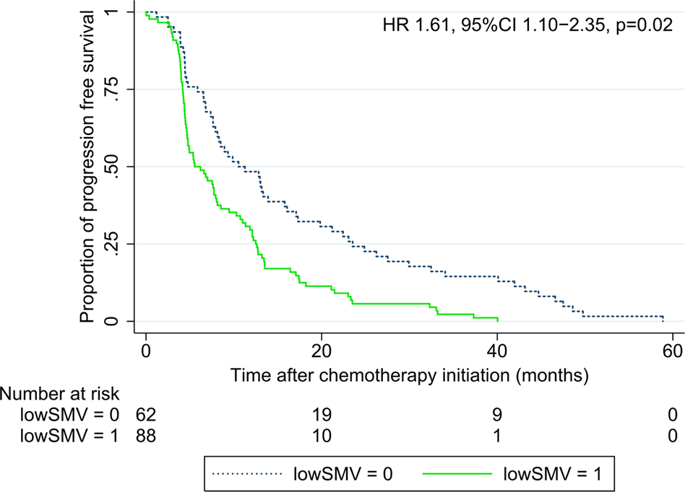当前位置:
X-MOL 学术
›
Prostate Cancer Prostatic. Dis.
›
论文详情
Our official English website, www.x-mol.net, welcomes your
feedback! (Note: you will need to create a separate account there.)
Assessment of body composition in the advanced stage of castration-resistant prostate cancer: special focus on sarcopenia.
Prostate Cancer and Prostatic Diseases ( IF 5.1 ) Pub Date : 2019-11-19 , DOI: 10.1038/s41391-019-0186-6 Judith Stangl-Kremser 1 , Rodrigo Suarez-Ibarrola 1 , David D' Andrea 1 , Stephan M Korn 1 , Mario Pones 1 , Gero Kramer 1 , Maximilian Marhold 2 , Michael Krainer 2 , Dmitry V Enikeev 3 , Petr V Glybochko 3 , Dietmar Tamandl 4 , Shahrokh F Shariat 1, 3, 5, 6, 7, 8 , Pascal Baltzer 4
Prostate Cancer and Prostatic Diseases ( IF 5.1 ) Pub Date : 2019-11-19 , DOI: 10.1038/s41391-019-0186-6 Judith Stangl-Kremser 1 , Rodrigo Suarez-Ibarrola 1 , David D' Andrea 1 , Stephan M Korn 1 , Mario Pones 1 , Gero Kramer 1 , Maximilian Marhold 2 , Michael Krainer 2 , Dmitry V Enikeev 3 , Petr V Glybochko 3 , Dietmar Tamandl 4 , Shahrokh F Shariat 1, 3, 5, 6, 7, 8 , Pascal Baltzer 4
Affiliation

|
PURPOSE
To assess the prevalence of sarcopenia and whether body composition parameters are associated with disease progression and overall survival (OS) in castration-resistant prostate cancer (CRPC) patients.
MATERIALS AND METHODS
This single-centre retrospective study evaluated data of 186 consecutive patients who underwent chemohormonal therapy between 2005 and 2016 as first-line systemic treatment for CRPC. Skeletal muscle and fat indices were determined using computerized tomography data before initiation of chemotherapy. Sarcopenia was defined as SMI of <55 cm2/m2. Visceral-to-subcutaneous fat ratio and skeletal muscle volume were calculated with body composition specific areas. Harrell's concordance index was used for predictive accuracy.
RESULTS
A total of 154 (82.8%) patients met the criteria for sarcopenia; 139 (74.7%) individuals completed at least six cycles of docetaxel. Within a median follow-up of 24.1 months, age (HR 1.03, 95% CI 1.01-1.06, p = 0.02), high PSA (1.55, 95% CI 1.07-2.25, p = 0.02) and low skeletal muscle volume (HR 1.61, 95% CI 1.10-2.35, p = 0.02) were the only independent prognostic factor for tumor progression. Overall, 93 (50%) patients died during the follow-up period. The established prognosticator, the prechemotherapy presence of liver metastases (HR 1.32, 95% CI 1.08-1.61, p < 0.01) was associated with shorter OS. Moreover, we noted that patients with an elevated visceral-to-subcutaneous fat ratio tended to have a shorter OS (p = 0.06).
CONCLUSION
The large majority of men with CRPC suffers from sarcopenia. In our cohort, low skeletal muscle volume was an independent adverse prognosticator for progression of disease. We could not detect a statistically significant body composition parameter for OS, although patients with a high proportion of visceral fat had a trend for shorter OS. However, we suggest that body composition parameters determined by CT data can provide useful objective prognostic factors that may support tailored treatment decision-making.
中文翻译:

评估去势抵抗性前列腺癌晚期的身体成分:特别关注少肌症。
目的评估去势抵抗性前列腺癌(CRPC)患者的少肌症的患病率以及身体组成参数是否与疾病进展和总体生存(OS)相关。材料与方法这项单中心回顾性研究评估了2005年至2016年间接受186例化学激素治疗作为CRPC一线全身治疗的连续患者的数据。在开始化疗之前,使用计算机断层扫描数据确定骨骼肌和脂肪指数。肌肉减少症定义为SMI <55 cm2 / m2。内脏与皮下脂肪比和骨骼肌体积是根据身体成分的特定面积计算的。Harrell的一致性指数用于预测准确性。结果共有154例(82.8%)患者符合肌肉减少症的标准;139(74。7%)的个体完成了至少6个多西他赛周期。在24.1个月的中位随访中,年龄(HR 1.03,95%CI 1.01-1.06,p = 0.02),高PSA(1.55,95%CI 1.07-2.25,p = 0.02)和低骨骼肌容量(HR 1.61,95%CI 1.10-2.35,p = 0.02)是肿瘤进展的唯一独立预后因素。总体上,有93名(50%)患者在随访期间死亡。既定的预后因素是肝转移的化疗前治疗(HR 1.32,95%CI 1.08-1.61,p <0.01)与较短的OS有关。此外,我们注意到内脏与皮下脂肪比率升高的患者的OS往往更短(p = 0.06)。结论绝大多数患有CRPC的男性患有肌肉减少症。在我们的队列中,骨骼肌体积低是疾病进展的独立不良预后指标。尽管内脏脂肪比例高的患者存在OS较短的趋势,但我们无法检测到OS的统计学上显着的身体成分参数。但是,我们建议由CT数据确定的身体成分参数可以提供有用的客观预后因素,这些因素可能支持量身定制的治疗决策。
更新日期:2019-11-19
中文翻译:

评估去势抵抗性前列腺癌晚期的身体成分:特别关注少肌症。
目的评估去势抵抗性前列腺癌(CRPC)患者的少肌症的患病率以及身体组成参数是否与疾病进展和总体生存(OS)相关。材料与方法这项单中心回顾性研究评估了2005年至2016年间接受186例化学激素治疗作为CRPC一线全身治疗的连续患者的数据。在开始化疗之前,使用计算机断层扫描数据确定骨骼肌和脂肪指数。肌肉减少症定义为SMI <55 cm2 / m2。内脏与皮下脂肪比和骨骼肌体积是根据身体成分的特定面积计算的。Harrell的一致性指数用于预测准确性。结果共有154例(82.8%)患者符合肌肉减少症的标准;139(74。7%)的个体完成了至少6个多西他赛周期。在24.1个月的中位随访中,年龄(HR 1.03,95%CI 1.01-1.06,p = 0.02),高PSA(1.55,95%CI 1.07-2.25,p = 0.02)和低骨骼肌容量(HR 1.61,95%CI 1.10-2.35,p = 0.02)是肿瘤进展的唯一独立预后因素。总体上,有93名(50%)患者在随访期间死亡。既定的预后因素是肝转移的化疗前治疗(HR 1.32,95%CI 1.08-1.61,p <0.01)与较短的OS有关。此外,我们注意到内脏与皮下脂肪比率升高的患者的OS往往更短(p = 0.06)。结论绝大多数患有CRPC的男性患有肌肉减少症。在我们的队列中,骨骼肌体积低是疾病进展的独立不良预后指标。尽管内脏脂肪比例高的患者存在OS较短的趋势,但我们无法检测到OS的统计学上显着的身体成分参数。但是,我们建议由CT数据确定的身体成分参数可以提供有用的客观预后因素,这些因素可能支持量身定制的治疗决策。











































 京公网安备 11010802027423号
京公网安备 11010802027423号